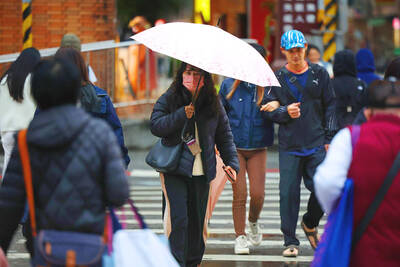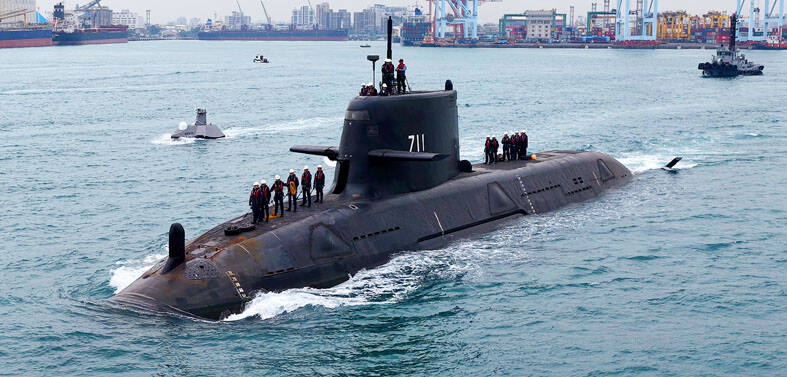A long-range early-warning radar system that the air force is to buy from the US is scheduled to become operational in five years, defense sources said yesterday. The system will be capable of detecting both the ballistic missiles and cruise missiles that China might use in an attack on Taiwan.
The early-warning radar is designed to provide sufficient time for the military to prepare for missile attacks from China, whether of the ballistic or cruise missile type. It would serve as the eyes for the Patriot PAC-3 anti-missile system that the army is to buy from the US.
In a recent closed-door briefing for legislators on the Legislative Yuan's National Defense Committee, the air force expressed optimism about the benefits of the much-anticipated early-warning radar. But one of the legislators who attended the briefing said that if he were a military leader, he would not be so optimistic.
The legislator, who declined to be identified because an agreement with the military prevents him from disclosing the contents of the briefing, said the early-warning radar would be effective only for a short time since it could not detect all of the ballistic and cruise missiles in China's inventory.
"But even considering the limited capabilities of the early-warning radar that the US is to sell us, the system is still necessary for us to defend against missile threats from China," the legislator said.
The air force has not made public what kind of early-warning radar it plans to buy from the US, but two types have been reported to be under consideration. One is the PAVEPAW system, made by Raytheon, and the other is a modified version of Lockheed Martin's SPY-1 radar, which is currently under development. SPY-1 is a radar system for AEGIS-class ships.
The PAVEPAW has a range of 3,000km while the modified version of the SPY-1 has a much shorter range.
A defense official said that a longer-range radar system like the PAVEPAW is much more desirable than a shorter-range, one but that shorter-range systems achieve greater accuracy.
The air force initially planned to buy two sets of long-range early-warning radar but now plans to buy only one because of budget constraints.
The cost of buying two sets of radar has been estimated at about NT$30 billion (US$909 million).
Two deployment sites were chosen over three years ago for the two early-warning radars. One site is in northern Hsinchu County and the other in southern Pingtung County. As the planned purchase has been reduced from two sets to one, the Pingtung site has been abandoned in favor of the one in Hsinchu.
Chinese Nationalist Party (KMT) Legislator Kao Chung-yuan (
"We must try to establish satellite links for the anti-missile defense system that is to be comprised of long-range early-warning radar and missile defense systems such as the PAC-III. We do not see the possibility of acquiring such vital satellite links any time soon," Kao said.

SHIPS, TRAINS AND AUTOMOBILES: The ministry has announced changes to varied transportation industries taking effect soon, with a number of effects for passengers Beginning next month, the post office is canceling signature upon delivery and written inquiry services for international registered small packets in accordance with the new policy of the Universal Postal Union, the Ministry of Transportation and Communications said yesterday. The new policy does not apply to packets that are to be delivered to China, the ministry said. Senders of international registered small packets would receive a NT$10 rebate on postage if the packets are sent from Jan. 1 to March 31, it added. The ministry said that three other policies are also scheduled to take effect next month. International cruise ship operators

NUMBERS IMBALANCE: More than 4 million Taiwanese have visited China this year, while only about half a million Chinese have visited here Beijing has yet to respond to Taiwan’s requests for negotiation over matters related to the recovery of cross-strait tourism, the Tourism Administration said yesterday. Taiwan’s tourism authority issued the statement after Chinese-language daily the China Times reported yesterday that the government’s policy of banning group tours to China does not stop Taiwanese from visiting the country. As of October, more than 4.2 million had traveled to China this year, exceeding last year. Beijing estimated the number of Taiwanese tourists in China could reach 4.5 million this year. By contrast, only 500,000 Chinese tourists are expected in Taiwan, the report said. The report

Temperatures are forecast to drop steadily as a continental cold air mass moves across Taiwan, with some areas also likely to see heavy rainfall, the Central Weather Administration (CWA) said. From today through early tomorrow, a cold air mass would keep temperatures low across central and northern Taiwan, and the eastern half of Taiwan proper, with isolated brief showers forecast along Keelung’s north coast, Taipei and New Taipei City’s mountainous areas and eastern Taiwan, it said. Lows of 11°C to 15°C are forecast in central and northern Taiwan, Yilan County, and the outlying Kinmen and Lienchiang (Matsu) counties, and 14°C to 17°C

STEERING FAILURE: The first boat of its class is experiencing teething issues as it readies for acceptance by the navy, according to a recent story about rudder failure The Hai Kun (海鯤), the nation’s first locally built submarine, allegedly suffered a total failure of stern hydraulic systems during the second round of sea acceptance trials on June 26, and sailors were forced to manually operate the X-rudder to turn the submarine and return to port, news Web site Mirror Daily reported yesterday. The report said that tugboats following the Hai Kun assisted the submarine in avoiding collisions with other ships due to the X-rudder malfunctioning. At the time of the report, the submarine had completed its trials and was scheduled to begin diving and surfacing tests in shallow areas. The X-rudder,